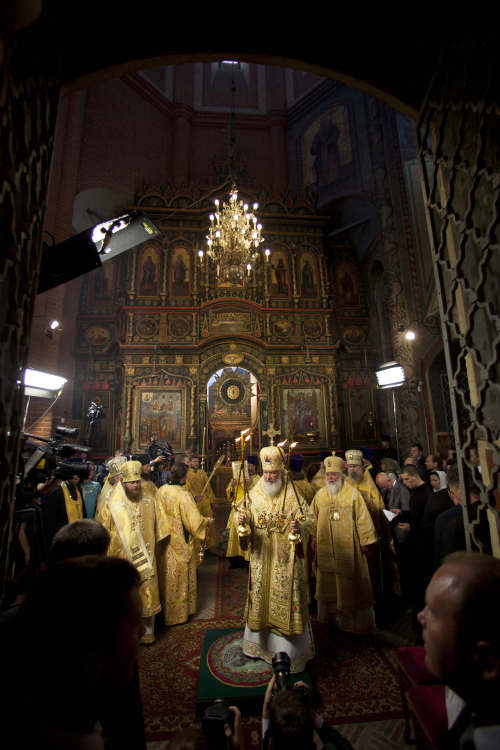MOSCOW (AP) ― He was naked, homeless and fiercely argumentative ― and his name is immortalized in one of Russia’s most remarkable buildings, St. Basil’s Cathedral.
An exhibition detailing the lives of St. Basil and other religious zealots known as “holy fools” opened Tuesday as part of ceremonies marking the 450th anniversary of perhaps Moscow’s most famous tourist attraction.
After years of restoration work that cost 390 million rubles ($14 million) ― including the reinforcement of the walls and the pile of brightly colored onion domes and spires that crown the architectural fantasia ― the iconic church looks lavish, and a striking contrast to the extreme asceticism that the holy fools practiced.
An exhibition detailing the lives of St. Basil and other religious zealots known as “holy fools” opened Tuesday as part of ceremonies marking the 450th anniversary of perhaps Moscow’s most famous tourist attraction.
After years of restoration work that cost 390 million rubles ($14 million) ― including the reinforcement of the walls and the pile of brightly colored onion domes and spires that crown the architectural fantasia ― the iconic church looks lavish, and a striking contrast to the extreme asceticism that the holy fools practiced.

Although originally named the Cathedral of the Intercession of the Virgin by the Moat, most know it as St. Basil’s, referring to Basil the Blessed, a Muscovite “holy fool” who was buried on the original site before the present building was erected.
The “holy fools” braved Russian winters by walking stark naked ― or mortified their flesh by wearing heavy fetters or lice-infested sackclothes. They fasted and never slept indoors, uttered prophecies, performed healings and even walked on water, according to their hagiographies.
And they dared to speak the truth to the powerful, being virtually the only group that could openly criticize the Kremlin rulers and channel ordinary people’s frustration.
“They manifested the people’s will,” Tatiana Saracheva, director of the museum at St. Basil’s, told The Associated Press.
“It was only the holy fools who could directly tell the royals about the troubles they inflicted on the Russian people.”
St. Basil was a peasant’s son nicknamed “the Naked Walker” and revered by Muscovites for healings and prophecies.
His nakedness, however, was “hardly shocking” to Russians who often bathed nude in saunas with their wives and children, says the exhibition’s artistic director, Andrey Reyner.
St. Basil fearlessly lambasted the tyrannical policies of Ivan the Terrible ― one of the Russia’s most violent czars.
And the moody, pious czar, whose slaughters claimed tens of thousands of lives, feared the naked ascetic whom he considered “the seer of people’s hearts and minds,” according to a church chronicle.
When St. Basil got sick, the czar and his wife Anastasia visited him, and after the ascetic’s death, Ivan personally carried his coffin to the grave right outside the Kremlin.
After winning several decisive victories over the Mongol rulers who once dominated medieval Russia, Ivan commissioned a massive cathedral that was erected over Basil’s burial site.










![[Today’s K-pop] BTS pop-up event to come to Seoul](http://res.heraldm.com/phpwas/restmb_idxmake.php?idx=644&simg=/content/image/2024/04/17/20240417050734_0.jpg&u=)





![[KH Explains] Hyundai's full hybrid edge to pay off amid slow transition to pure EVs](http://res.heraldm.com/phpwas/restmb_idxmake.php?idx=652&simg=/content/image/2024/04/18/20240418050645_0.jpg&u=20240419100350)

